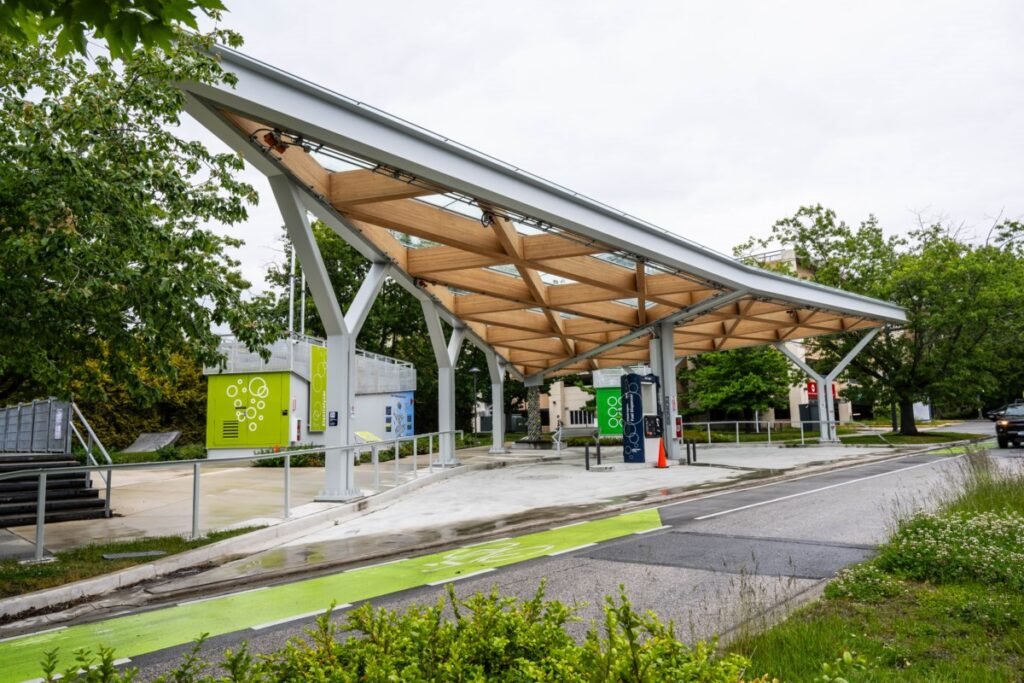The Fusion of Elements: British Columbia’s Leap into a Hydrogen Future
Nestled within the verdant expanses of the University of British Columbia, a groundbreaking initiative emerges, poised to redefine the energy landscape. The Smart Hydrogen Energy District (SHED), a $23 million beacon of innovation, stands ready to harness the synergy of hydropower and solar energy to produce hydrogen, a venture that blends the elemental forces of water and sun into a sustainable fuel of tomorrow.
A Confluence of Currents and Sunlight
British Columbia’s natural tapestry, woven with rivers and sunlight, provides a nearly idyllic setting for such an endeavor. The province, already tapping into the kinetic dance of its waterways for electricity, now sets its sights on the sun’s radiant energy to further its ecological narrative. The SHED is a testament to this commitment, serving as a crucible where the flow of rivers and the journey of photons converge to birth hydrogen fuel.
The Micro-Grid: A Tapestry of Renewable Resources
The University of British Columbia’s SHED is not simply a facility; it is a microcosm of possibility. Here, hydropower and solar energy are married through the process of water electrolysis, creating a micro-grid where renewable sources are not only connected but unified. This pioneering site emerges as one of Canada’s first to integrate such a trinity of clean energy sources, charting a course for a future where light- and heavy-duty vehicles draw sustenance from a hydrogen station birthed from sustainability.

The Vision of SHED: A Clean Economy and a Global Beacon
The Honourable Josie Osborne, Minister of Energy, Mines and Low Carbon Innovation, heralds the SHED as a stride towards a pristine economy and a beacon for global leadership in the hydrogen economy. This district is an embodiment of CleanBC’s aspirations, interweaving energy, transportation, and urban design into a fabric that not only supports the province’s ecological ambitions but also cements its status as a vanguard in the hydrogen domain.
A Model of Urban Integration: Technology Meets Cityscape
SHED’s blueprint is a microcosm of urban ingenuity—a city block where technology breathes life into compact urban planning. A rooftop solar array not only fuels the hydrogen station but also energizes electric vehicle (EV) charging stations. This innovative ecosystem is designed for reciprocity; EVs can draw from and contribute to the grid, becoming dynamic participants in a dance of energy exchange during periods of peak demand.
The Role of Hydrogen in a Low-Carbon Transition
Dr. Walter Mérida, a visionary in mechanical engineering and the research lead of SHED, sees hydrogen as the linchpin in Canada’s shift to a low-carbon economy. SHED is more than a project; it is a demonstration of hydrogen as a conduit between renewable electricity and sustainable energy services. Dr. Mérida envisions a future where our networks—gas, electrical, digital—are not disparate but interconnected, and parked cars transform into collective power banks that stabilize the grids of tomorrow.
The Nexus of Connectivity: A 5G-Enabled Research Hub
A secure 5G network is the sinew that binds SHED’s diverse systems, granting researchers the power to craft digital simulations that will propel advancements in energy, transportation, and urban planning. This digital backbone is key to navigating the complex interplay of a city’s lifeblood—its energy and mobility flows.
A Coalition of Support: Funding the Future
The SHED initiative draws strength from a spectrum of partners, with contributions spanning from the Ministry of Energy, Mines and Low Carbon Innovation’s low-carbon fuel standard credits to the Government of Canada, the Canada Foundation for Innovation, the British Columbia Knowledge Development Fund, and industry collaborators like HTEC. This financial mosaic is a testament to the collective resolve to fuel a clean energy revolution.

























![[Cultivating Independence] The Rise of Domestic Lithium-Ion Battery Supply Chains in the U.S.](https://evergreenvitality.com/wp-content/uploads/2024/12/ev-battery-robots-factory-istock-1456466947-360x180.jpg)













![[Cultivating Independence] The Rise of Domestic Lithium-Ion Battery Supply Chains in the U.S.](https://evergreenvitality.com/wp-content/uploads/2024/12/ev-battery-robots-factory-istock-1456466947-120x86.jpg)


